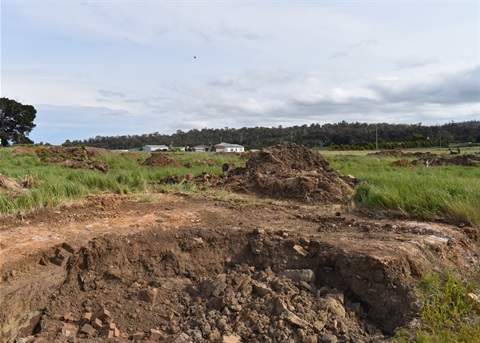
Last year, an archaeological dig supported by the City of Launceston attempted to locate the remnants of the former Kings Meadows Convict Road Station on private land at Kings Meadows.
Local historian and surveyor John Dent believed he could pinpoint the site's location using historical records and survey plans, and approached the Council with a proposal for a small exploratory dig.
Approval from landowners in the area was sought and received to recover artefacts of interest before the site was redeveloped for residential housing.
The remnants of the site were discovered late last year on land already approved for residential development, and artefacts recovered included bottles, bricks, and other household items.
Little of the original building's foundations remained due to agricultural and other activity on the site over the decades.
Shortly after the discovery of the site, the Tasmanian Heritage Council received a nomination for state listing for the site.
This week, the Tasmanian Heritage Council determined that the site did not meet the criteria for entry onto the Tasmanian Heritage Register.
Now that the THC's processes are complete, the City of Launceston has published its archaeological report on the site here.
Launceston Mayor Albert van Zetten said the Council was proud of the work undertaken in partnership with the landowner and Mr Dent to locate and catalogue the site.
"It is only through the detective work of historian John Dent and the assistance of the landowner Darren Goodyer that we were able to understand the history of the site, and had the opportunity to catalogue and record the remaining artefacts for future generations," Mayor van Zetten said.
"The Council would like to thank both the developer for his patience and cooperation during this lengthy but important process, and the Heritage Council for its considered approach in reaching this decision.
"The City of Launceston now looks forward to the completion of this much-needed residential development — which was approved before the discovery — to cater for Launceston's growing housing demand."
The media release from the Tasmanian Heritage Council is republished below:
Tasmanian Heritage Council - MEDIA RELEASE DECISION ON KINGS MEADOWS CONVICT STATION SITE
12 December 2019
The Tasmanian Heritage Council has determined that the site of the former Kings Meadows Convict Station does not meet criteria for entry in the Tasmanian Heritage Register.
At its meeting on 10 December 2019, the Heritage Council concluded that although the convict story is highly important for Tasmania, the site of the convict station no longer had sufficient associated physical remains to warrant its inclusion in the Tasmanian Heritage Register.
'The Heritage Council acknowledges the importance of the wider convict story to Tasmania. However, in assessing the remaining heritage values of this specific parcel of land, and concluded that it did not meet the registration criteria to a sufficient degree to justify its entry in the Heritage Register', said Ms Brett Torossi, Chair of the Tasmanian Heritage Council.
'The site was only revealed as a result of works undertaken for an approved subdivision. The City of Launceston, the owner and the archaeological consultant involved are to be congratulated on working so proactively to ensure that the valuable information that this site possessed could be uncovered and recorded.'
The works to subdivide and install road, service and related infrastructure to prepare the land for housing had been previously approved by the City of Launceston, and these works had commenced prior to any knowledge of the land having once been the site of the former convict station.
The Heritage Council's decision followed an extensive program of historical research and archaeological investigations and a detailed assessment of the site's heritage significance against each of the eight registration criteria contained in the Historic Cultural Heritage Act 1995.
This work showed that the site was established as a work camp in August 1836, with the Convict Station constructed and occupied in July 1837, but closed approximately six months later, following the abandonment of the Evandale to Launceston Water Scheme.
Archaeological investigations confirmed that a large portion of the remaining site had been severely impacted from post-convict agricultural activity and more recently, the initial works relating to the construction of the subdivision, which commenced before the location of the convict station had been revealed and the nomination received by the Heritage Council.
'The Heritage Council's conclusion was that the combination of these factors have reduced the heritage values and diminished the integrity of its features to the point where entering the site on the Heritage Register could not be justified. Instead, the emphasis will be on exploring if the archaeological reports can be made available to the public, transferring the artefacts from the site to a suitable repository and how to best interpret and share the story of the site.'
The Heritage Council has also agreed to review the entry in the Heritage Register for the Evandale to Launceston Water Scheme - which currently includes reference to the Kings Meadows Convict Station and plans to identify early and important convict sites across Tasmania that are not heritagelisted, but might warrant recognition in the future.
The Heritage Council will also explore a strategy for the better identification and assessment of sites of high archaeological value that are not yet recognised in the Heritage Register.






